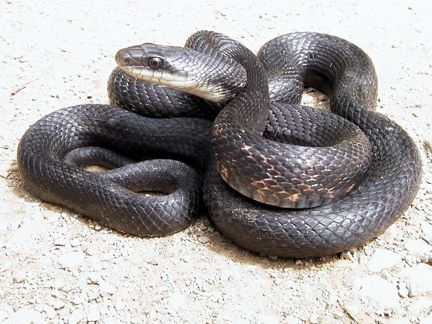
It’s a Leap Year so the rat snake is enjoying one extra day as being our Animal of the Month for February. But as it’s the 29th, we do have to finally bid the rat snake a fond farewell for now. We hope you enjoyed our tweets all month long about these snakes who are citizens of the world. But if you missed any of our tweets, here is a summary. Did you know?:
- Rat snakes (Pantherophis [Elaphe] obsoleta) include a wide variety of different species of snakes – some estimates range between 40 and 55 species altogether.
- Rat snakes are divided into two big groups – Old World and New World rat snakes. The Old World rat snakes are found in parts of Europe and Asia, while the New World rat snakes are found in North America.
- There is some controversy about the scientific name and classification of rat snakes. In 2002, herpetologist Urs Utiger suggested reclassifying New World rat snakes under the genus Pantherophis while the Old World rat snakes would stay in the genus of Elaphe.
- Utiger made the proposal based on findings of newly-discovered DNA differences between the rat snakes, but it has been met with mixed reaction within the scientific community.
- For example, Pantherophis has been accepted as the genus for New World rat snakes by the Society for the Study of Amphibians and Reptiles. But the International Commission on Zoological Nomenclature does not recognize Pantherophis.
- Just as they are found in a variety of countries around the world, rat snakes can also live in a wide variety of habitats and elevations above sea level.
- Rat snakes can be found almost anywhere from agricultural land to rocky hills and mountainous areas, forests and even the suburbs.
- Wild New World rat snakes in North America live in most parts of the eastern U.S. and can be found west to Kansas and Oklahoma and as far south as Texas. They are also found in southern Ontario; the species being the gray rat snake (Pantherophis spiloides) and it’s the largest snake found in Ontario.
- Even within southern Ontario, the gray rat snake is separated into two distinct populations – one in southwestern Ontario; the other in the southeastern part of the province.
- The gray rat snake population in southwestern Ontario is concentrated mainly along the north shore of Lake Erie. It is called the Carolinian population and it is listed as endangered.
- The southeastern Ontario gray rat snake population is called the Frontenac Axis and it is found within the area roughly bordered by Kingston, Brockville, Perth and Sharbot Lake. This population is listed as threatened.
- Interestingly, the two wild Ontario rat snake populations live in different habitats with the Carolinian are found in a mix of agricultural land and forest; while the Frontenac Axis also lives in rocky areas, wetlands and lakes.
- NEVER take rat snakes from the wild to keep as pets! It is illegal and threatens wild populations. If you want to bring a rat snake into your family, you must do so through a reputable breeder.
- Generally-speaking, rat snakes are medium-to-large-sized snakes. As adults, they usually grow to a length of between 1 to 2 metres (3.5-6 feet). But there are some rat snakes species who can grow in excess of 2.5 metres (8 feet).
- Just as there are many different species of rat snakes and their geographic range in the wild is large, there are many different colours and pattern variations of rat snakes’ skin.
- Rat snakes can have blotched or striped skin or even a combination of the both. They can also be solid in colour. And the colours of their skin can vary from black to white and many other colours in between!
- The pupils of rat snakes are round as opposed to the cat-like oblong pupil shape found in other types of snakes. While there are always exceptions to the rule, round pupils are usually found in nonvenomous snakes like rat snakes.
- Rat snakes also have slender bodies with keeled scales, which means their scales have a ridge running down the center of each scale. This gives the scales a bit of a rougher feel to the touch and it also helps rat snakes climb trees and structures.
- As their name suggests, rat snakes eat rats. They also eat other rodents like mice, voles and chipmunks. Eggs, small birds, frogs and lizards can also be part of their diet in the wild.
- Rat snakes are both foragers and ambush hunters; meaning they will actively hunt for food, but they will also wait for prey to cross their paths and grab their meals that way.
- Because they are nonvenomous, rat snakes kill their prey by constriction. They quickly grab their prey with their teeth and then wrap around the animal, squeezing tightly.
- When rat snakes are juveniles and smaller in size, their predators include birds of prey – such as owls and hawks – foxes and raccoons.
- As adults, rat snakes have one predator – people. While rat snakes don’t pose any threat to people, people are the biggest threat to rat snakes. People will kill them out of fear or ignorance. Habitat destruction and vehicle strikes also threaten rat snakes.
- Rat snakes are harmless; but when threatened they will vibrate their tails like a rattlesnake, which is venomous. This is a good example of Batesian mimicry, where a harmless animal imitates the behaviour of a more harmful animal to protect himself from threats.
- Another defense mechanism that rat snakes may employ is the discharge of a foul-smelling liquid from their anal glands. They may also strike at and bite whoever is threatening them.

